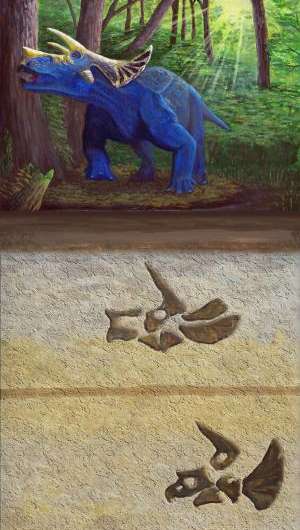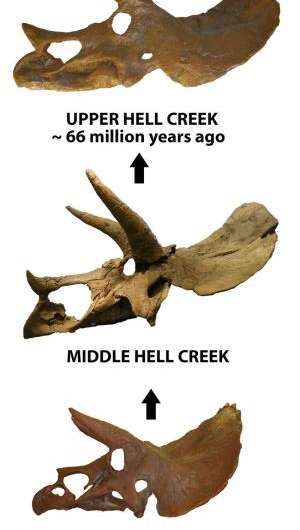This image shows the evolution of the Triceratops in the Hell Creek Formation of Eastern Montana. Credit: Holly Woodward
(Phys.org) —A study of Triceratops fossils at Hell Creek Formation in Montana has provided insight into the evolution of these dinosaurs. John Scannella of Montana State University and his team examined more than 50 skulls of the two known Triceratops species and, based on morphological differences and placement in the strata, determined that one species transformed into the other. The research appears in the Proceedings of the National Academy of Sciences.
Paleontologists have identified two Triceratops species, Triceratops horridus and Triceratops prorsus, based on the length and shape of the horns and the size and structure of the skull. However, they have been unsure of the evolutionary relationship between the two. The two species could have been descendants of an earlier dinosaur, evolving as their ancestor's evolutionary tree split into two branches, in a process known as cladogenesis. If this were the case, both species would have lived at the same time, probably in different locations, where they would have developed adaptations appropriate for their distinct environments. Another possibility is that one species transformed into the other, in a process called anagenesis, with the earlier species dying out before the later one came into existence. Some researchers have suggested that T. horridus and T. prorsus could be different sexes of the same species.
Unfortunately, when scientists study dinosaur evolution, they often don't have enough fossils to make accurate conclusions. A 1992 study suggested that anagenesis caused the evolution of the two Triceratops species, but critics argued that the study did not use enough samples.
Scannella's team was able to rectify this problem by studying Triceratops skulls found at Montana's Hell Creek Formation, which contains many fossils from a one to two million year period during the Upper Cretaceous. The Hell Creek Project, a survey of the flora, fauna and geology at the formation, took place between 1990 and 2010. Of all the dinosaur fossils found, Triceratops fossils have been the most abundant. More than 50 Triceratops skulls were unearthed at the site.
Evolutionary changes in Triceratops from the Hell Creek Formation of Montana include enlargement of the nasal horn over time. Credit: PNAS
The Hell Creek Formation contains lower, middle and upper subdivisions. When the team studied Triceratops skulls' morphology and position in the strata, they found that skulls showing only features of T. horridus appeared only in the lower section, while skulls exhibiting only T. prorsus features appeared only in the upper section. Skulls found in the middle contained a combination of features of both species. This placement shows that the two species lived in the same place at different times. Therefore, T. horridus and T. prorsus probably did not evolve via cladogenesis, and they could not represent two sexes of a single species. The fossil record shows that T. horridus probably evolved into T. prorsus over one to two million years.
More information: Evolutionary trends in Triceratops from the Hell Creek Formation, Montana, PNAS, www.pnas.org/cgi/doi/10.1073/pnas.1313334111
Abstract
The placement of over 50 skulls of the well-known horned dinosaur Triceratops within a stratigraphic framework for the Upper Cretaceous Hell Creek Formation (HCF) of Montana reveals the evolutionary transformation of this genus. Specimens referable to the two recognized morphospecies of Triceratops, T. horridus and T. prorsus, are stratigraphically separated within the HCF with the T. prorsus morphology recovered in the upper third of the formation and T. horridus found lower in the formation. Hypotheses that these morphospecies represent sexual or ontogenetic variation within a single species are thus untenable. Stratigraphic placement of specimens appears to reveal ancestor–descendant relationships. Transitional morphologies are found in the middle unit of the formation, a finding that is consistent with the evolution of Triceratops being characterized by anagenesis, the transformation of a lineage over time. Variation among specimens from this critical stratigraphic zone may indicate a branching event in the Triceratops lineage. Purely cladogenetic interpretations of the HCF dataset imply greater diversity within the formation. These findings underscore the critical role of stratigraphic data in deciphering evolutionary patterns in the Dinosauria.
Journal information: Proceedings of the National Academy of Sciences
© 2014 Phys.org






















